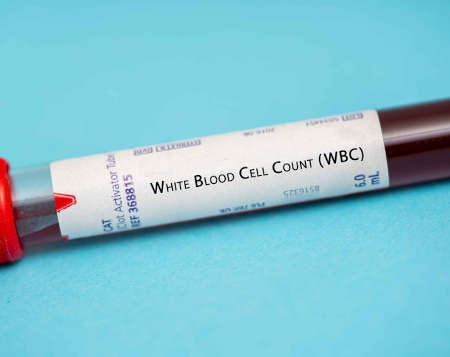
Perhaps your vet has run bloodwork during an annual wellness exam, or maybe your dog hasn’t been feeling well and needs a diagnostic workup. There are many reasons a veterinarian may recommend bloodwork, such as a complete blood count – but what if the results show that your dog has a high white blood count?
As a veterinarian, I have run this blood test countless times. A high white blood cell count is something that many pet parents have questions and concerns about. And there are numerous possible causes, ranging from minor to serious. Let’s explore more about white blood cells, possible reasons they may be elevated, and the next steps that your vet might recommend.
Overview of high white blood cell count in dogs

White blood cells (WBC), also known as leukocytes, are pivotal parts of a dog’s immune system. They act as sentinels against infections and other potential threats. There are five main types that work independently and together to help fight infection and inflammation. Here is a very simplified breakdown:
- Neutrophils: Primarily combat inflammation and infections.
- Lymphocytes: Crucial for antibody production and immunity.
- Monocytes: Engage in the removal of debris.
- Eosinophils: Combat parasitic infections and play roles in allergic responses.
- Basophils: Involved in allergic reactions.
Your vet will measure your dog’s white blood cell levels with a test called a complete blood count (CBC). A CBC measures the total number of WBCs as well as the numbers of each type of WBC. It also provides information about the numbers of red blood cells (needed to deliver oxygen all over the body) and platelets (a critical component in blood clotting).
Your vet may also perform a blood smear, where they examine a drop of blood under the microscope to gather important information about the shape, size, and physical characteristics of the blood cells.
For dogs, a typical WBC count ranges between 6,000 to 17,000 (per microliter of blood). When levels surge above this range, it’s termed leukocytosis – a high white blood cell count – and can be caused by several different things.
How a high white blood cell count can impact a dog’s life

An elevated WBC count in dogs indicates a heightened immune response, often due to underlying conditions like infection, inflammation, or cancer. Physically, a dog with leukocytosis might exhibit symptoms ranging from fever and lethargy to more specific signs related to the underlying cause.
Persistent high WBC counts, especially if left untreated or related to chronic conditions, can adversely affect the dog’s quality of life. This might necessitate frequent veterinary visits, increased medical expenses, and alterations in the dog’s daily routine. Moreover, serious conditions behind the elevation, like certain cancers, could impact the dog’s life expectancy.
For both the dog and owner, navigating these health challenges can be emotionally demanding. It’s crucial for owners to collaborate with their veterinarians to pinpoint the root cause and implement a suitable treatment plan, ensuring the best possible quality of life for their pet.
My dog’s white blood cell count is very high. Is it a reason to be worried?
While white blood cells can sometimes be elevated due to stress, a high white blood cell count is more likely to indicate a medical concern such as infection. Unfortunately, extremely high WBC counts (for example, 100,000 or more) are most likely associated with leukemia.
Caring for a dog with high count of white blood cells
The best thing you can do for a dog with a high white blood cell count is to see your veterinarian for a thorough workup. Once the underlying cause has been determined, they will be able to make an appropriate treatment plan tailored to your dog.
How your veterinarian can help
Elevated WBC count can be due to several underlying issues, as discussed above. Your vet will likely recommend additional testing to determine what is going on. This may include other types of blood tests, a blood smear, bone marrow aspiration, and imaging such as X-rays and ultrasound.
Treatment hinges on identifying and addressing the root cause and may include:
- Antibiotics, antivirals, or anti-fungals for infections
- Anti-inflammatory medications for inflammation
- Chemotherapy for cancer
- Supportive care for cases where the exact cause can’t be pinpointed or for symptom relief
Additionally, proactive care such as scheduling regular veterinary appointments including routine bloodwork, keeping up to date on vaccines and preventatives against parasites, and staying vigilant for early signs of illness in your dog can help catch issues early when they may be easier to manage.
Top reasons causing high white blood cell count in dogs
1. Stress response
Dogs can have a temporary rise in WBC count due to acute stress or excitement, known as a “stress leukogram.” This typically follows a stressful event like a visit to the vet, a thunderstorm, or some form of trauma. Other signs that your dog is stressed might include panting, pacing, or hiding.
Creating a calm environment, playing calming music, using gentle massage, anxiety wraps, calming treats, and pheromones such as Adaptil may be beneficial. If stress is chronic or severe, behavioral therapy or anxiety medications might be prescribed by your vet. However, it is important that other medical causes of elevated WBC are not overlooked. Your vet may recommend repeating the blood test if they suspect stress is the culprit.
2. Inflammation (non-infectious)
Inflammation refers to the body’s response to injury or harmful stimuli. It can be acute (short-term) or chronic (long-term). Examples include autoimmune disorders, injuries, infections, and allergic reactions. Symptoms can vary widely but might include swelling, redness, heat, pain, or loss of function in the affected area.
For mild allergic reactions, over-the-counter antihistamines (after vet approval) can be beneficial. Cold compresses can help with localized inflammation. Depending on the cause, treatments can include anti-inflammatory medications, steroids, or other specific medications to treat the underlying cause of the inflammation.
3. Infections
Infections occur when harmful microorganisms, such as bacteria, viruses, or fungi, invade the body and multiply. Symptoms will vary depending on the underlying condition but might include fever, lethargy, loss of appetite, vomiting, diarrhea, respiratory signs (cough, increased respiratory rate), neurological signs, localized swelling, redness, and pus-filled or foul-smelling lesions.
Bacterial infections can be treated with antibiotics – either oral or topical, depending on the location and severity. Fungal infections will respond to anti-fungal medications. Viral infections often require supportive care, such as ensuring hydration and managing symptoms with medications. Preventative measures like vaccinations play a crucial role in protecting dogs from certain infections.
4. Cancer
Various types of cancer can cause elevated white blood cells, most notably leukemia, a cancer that originates in the blood-forming tissues, such as the bone marrow. It leads to an overproduction of abnormal white blood cells. There are different types of leukemia in dogs, with some being more aggressive than others. Symptoms might be non-specific and can include lethargy, weakness, loss of appetite, weight loss, pale gums, frequent infections, or unexplained bruises. Swollen lymph nodes, spleen, or liver can also occur.
Any suspicion of cancer warrants immediate veterinary attention. Treatment varies based on the type and stage of cancer. Chemotherapy is the most common treatment approach for leukemia. In some cases, supportive care like blood transfusions or antibiotics (to combat secondary infections) might be needed. The prognosis varies widely (from weeks to years) based on the specific type of leukemia and the stage at diagnosis.
5. Bone marrow disorders
Blood cells are produced within the bone marrow, and certain diseases can cause the production of too many or too few blood cells. Symptoms are often non-specific and can include fatigue, weakness, pallor, frequent infections, and increased bleeding or bruising. Veterinary attention is essential for proper diagnosis and management. Treatment can vary based on the specific disorder and may include chemotherapy, immunosuppressive drugs, and supportive care, like blood transfusions.
6. Other
Other conditions, such as endocrine disease, parasites, allergies, immune-mediated conditions, and more, can also cause elevated WBC. Lastly, individual dogs, or certain dog breeds, can have slight variations in their numbers of WBC.
Disclaimer: This website's content is not a substitute for veterinary care. Always consult with your veterinarian for healthcare decisions. Read More.


Be the first to comment